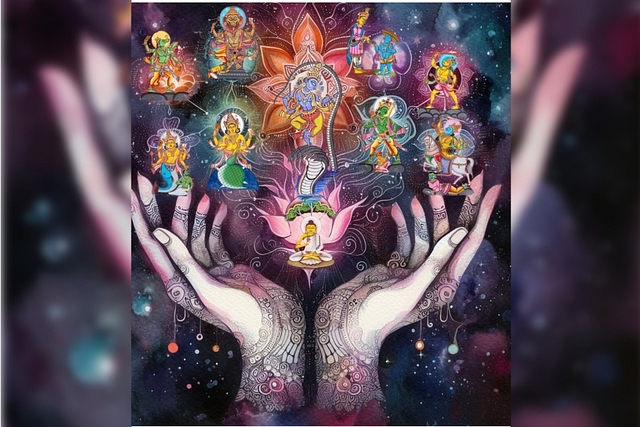Culture
Sahasra (Name 80) : When The Ten Forms Of Narayana Arise From Her
- On the seventh Navratri, we invoke the 80th name of the Goddess, who brought forth the ten forms of Narayana through her fingernails.

An impression of the 80th name from the Sri Lalitha Sahasranama
Aravindan Neelakandan's series on the Sri Lalitha Sahasranama has a new title, 'Sahasra'. This Navratri, we bring to you one article each from this series, each day.
The Brahmanda Purana describes the battle that rages between the forces catalysing self-realisation and the forces of inner stagnation.
The supremo of the Asuric forces is Bhandasura who has arisen from the ashes of Kama, from the scorched power of desire.
He unleashes an Asuric astra called Sarvasura astra. It brings back every dead Asura vanquished by Vishnu through His Dasavatara.
Asuras like Ravana, Hiranyaksha, Hiranyakasibu etc,. are all back in the battlefield.
In response, the Goddess, just from the nails of Her ten fingers, brings forth the ten divine descent-forms or Avataras of Maha Vishnu.
The 80th Name of the Goddess in the Sri Lalitha Sahasranama is Karanguli-nakhotpanna-Narayana-Dasakriti: the nails on the fingers of Her hands generate the ten forms of Nārāyaṇa.
Look at the parallels between the functions of the nails of Her feet and those of Her hand!
In the 44th Name Her toe nails are described as removing the inner darkness of those who surrender to Her. Now in the 80th Name, Her fingernails create the forms which fight and destroy the Asuric entities.
This echoes what the Ramayana says about the hands and feet of Sri Rama.
The hands of Sri Rama protected the yajna of Viswamitra by vanquishing and driving away the Asuric forces and on the way to Mithila, His feet touched the stone that had turned into Ahalya and removed the curse on her. Rama’s feet gave removed the inertia of curse and gave liberation to Ahalya.
In the Kamba Ramayana, a celebrated verse brings together the valorous nature of Rama’s hands in war and the compassion associated with His feet.
At the Varaha temple in Mahabalipuram, there is a famous inscription that lists the ten Avatars of Vishnu:
matsyaḥ kūrmo varāhaśca narasimho'th vamanaḥ
rāḥmo rāḥmasca krishṇaśca buddhaḥ kalki ca te daśa
This gives the list as:
-the fish which saved the Vedas concealed by Asuras
-the tortoise that enabled the churning of cosmic milk-ocean
-the boar that saved Earth from getting submerged in chaotic water
-Man-lion which killed the tyrant Asura Hiranya
-Vamana who took three strides across the universe
-Parashurama who punished the erring power elite
-Rama, the embodiment of Dharma
-Krishna who was the complete or purna Avatar, and
-Buddha, who is also considered one of the ten avatars of Vishnu.
The list ends with the Kalki avatar which would come in the future.
Bhaskararaya, in his commentary on the Sri Lalitha Sahasranama, also points out that the name 'Narayana' brings together the human and Divine.
Jiva, the human has five states of consciousness:
-Panchavasta – the waking stage
-Dream stage
-deep-sleep stage
-Turiya stage
-Turiyateeta state.
The Divine on the other hand has Panchakritya – five cosmic functions:
-Srishti (creation or emergence of manifest universe)
-Sthiti – its preservation
-Samhara – dissolving the forms back into condensed state
-Tirodhana (veiling the reality), and
-Anugraha (liberation).
The Goddess through Her fingernails brings together these five states of the jiva and the five functions of Isvara.
This is also a subtle hint that when there is a realisation of the true nature of the jiva by an individual, the individual doesn't become a God in the sense of creating worlds or commanding galactic destruction but realizes their identity with the Brahman.
Support Swarajya's 50 Ground Reports Project & Sponsor A Story
Every general election Swarajya does a 50 ground reports project.
Aimed only at serious readers and those who appreciate the nuances of political undercurrents, the project provides a sense of India's electoral landscape. As you know, these reports are produced after considerable investment of travel, time and effort on the ground.
This time too we've kicked off the project in style and have covered over 30 constituencies already. If you're someone who appreciates such work and have enjoyed our coverage please consider sponsoring a ground report for just Rs 2999 to Rs 19,999 - it goes a long way in helping us produce more quality reportage.
You can also back this project by becoming a subscriber for as little as Rs 999 - so do click on this links and choose a plan that suits you and back us.
Click below to contribute.
Latest